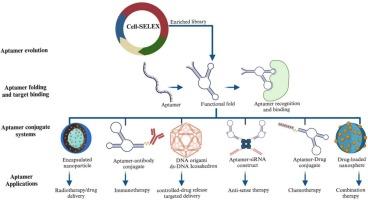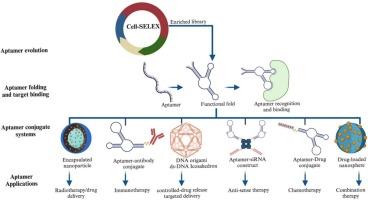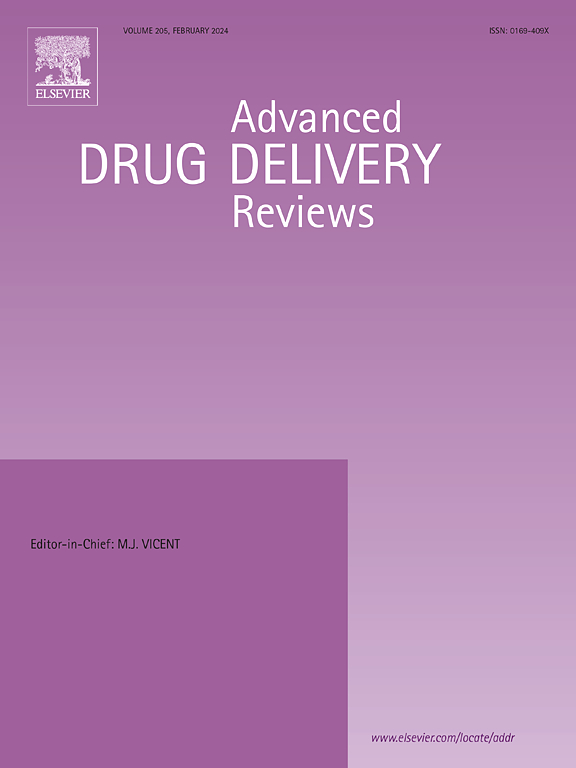适配体在药物传递中的特异性识别作用
IF 17.6
1区 医学
Q1 PHARMACOLOGY & PHARMACY
引用次数: 0
摘要
靶向药物递送显著提高了各种疾病的治疗效果,特别是在癌症治疗中,化疗和放疗等传统方法往往会造成严重的副作用。在这种情况下,核酸适体——能够以高亲和力结合特定靶标的短单链DNA或RNA寡核苷酸——已经成为精确药物输送和治疗的有希望的工具。适配体可以选择对整个,活细胞使用SELEX和化学修饰的不同应用。它们的化学通用性和特异性结合能力允许适体被设计成适体-药物偶联物、纳米颗粒、DNA折纸结构、双价/多价或双特异性结构。这些平台能够选择性地识别细胞或小分子上的独特分子特征,促进高度靶向的药物递送和在疾病部位的控制释放。这种精确性降低了全身毒性,提高了治疗效果。与抗体相比,适体具有几个优点,包括更快的组织渗透、更低的免疫原性、更大的化学稳定性和更好的体内生物利用度。本文综述了适体修饰策略的最新进展-共价和非共价-用于与化疗药物,金纳米颗粒(GNPs)和光敏剂结合。我们进一步评估了它们作为药物输送载体和治疗剂的潜力,并讨论了这些创新如何推动精准医疗的进步。本文章由计算机程序翻译,如有差异,请以英文原文为准。


Aptamers as target-specific recognition elements in drug delivery
Targeted drug delivery significantly enhances therapeutic efficacy across various diseases, particularly in cancer treatments, where conventional approaches such as chemotherapy and radiotherapy often cause severe side effects. In this context, nucleic acid aptamers—short, single-stranded DNA or RNA oligonucleotides capable of binding specific targets with high affinity—have emerged as promising tools for precision drug delivery and therapy. Aptamers can be selected against whole, living cells using SELEX and chemically modified for diverse applications. Their chemical versatility and specific binding capabilities allow aptamers to be engineered into aptamer-drug conjugates, nanoparticles, DNA origami structures, and bi-/multivalent or bispecific constructs. These platforms enable selective recognition of unique molecular signatures on cells or small molecules, facilitating highly targeted drug delivery and controlled release at the disease site. Such precision reduces systemic toxicity and enhances therapeutic outcomes. Compared to antibodies, aptamers offer several advantages, including faster tissue penetration, lower immunogenicity, greater chemical stability, and improved bioavailability in vivo. This review highlights recent advances in aptamer modification strategies—both covalent and non-covalent—for conjugation with chemotherapeutic agents, gold nanoparticles (GNPs), and photosensitizers. We further assess their potential as drug delivery vehicles and therapeutic agents and discuss how these innovations are driving progress in precision medicine.
求助全文
通过发布文献求助,成功后即可免费获取论文全文。
去求助
来源期刊
CiteScore
28.10
自引率
5.00%
发文量
294
审稿时长
15.1 weeks
期刊介绍:
The aim of the Journal is to provide a forum for the critical analysis of advanced drug and gene delivery systems and their applications in human and veterinary medicine. The Journal has a broad scope, covering the key issues for effective drug and gene delivery, from administration to site-specific delivery.
In general, the Journal publishes review articles in a Theme Issue format. Each Theme Issue provides a comprehensive and critical examination of current and emerging research on the design and development of advanced drug and gene delivery systems and their application to experimental and clinical therapeutics. The goal is to illustrate the pivotal role of a multidisciplinary approach to modern drug delivery, encompassing the application of sound biological and physicochemical principles to the engineering of drug delivery systems to meet the therapeutic need at hand. Importantly the Editorial Team of ADDR asks that the authors effectively window the extensive volume of literature, pick the important contributions and explain their importance, produce a forward looking identification of the challenges facing the field and produce a Conclusions section with expert recommendations to address the issues.

 求助内容:
求助内容: 应助结果提醒方式:
应助结果提醒方式:


